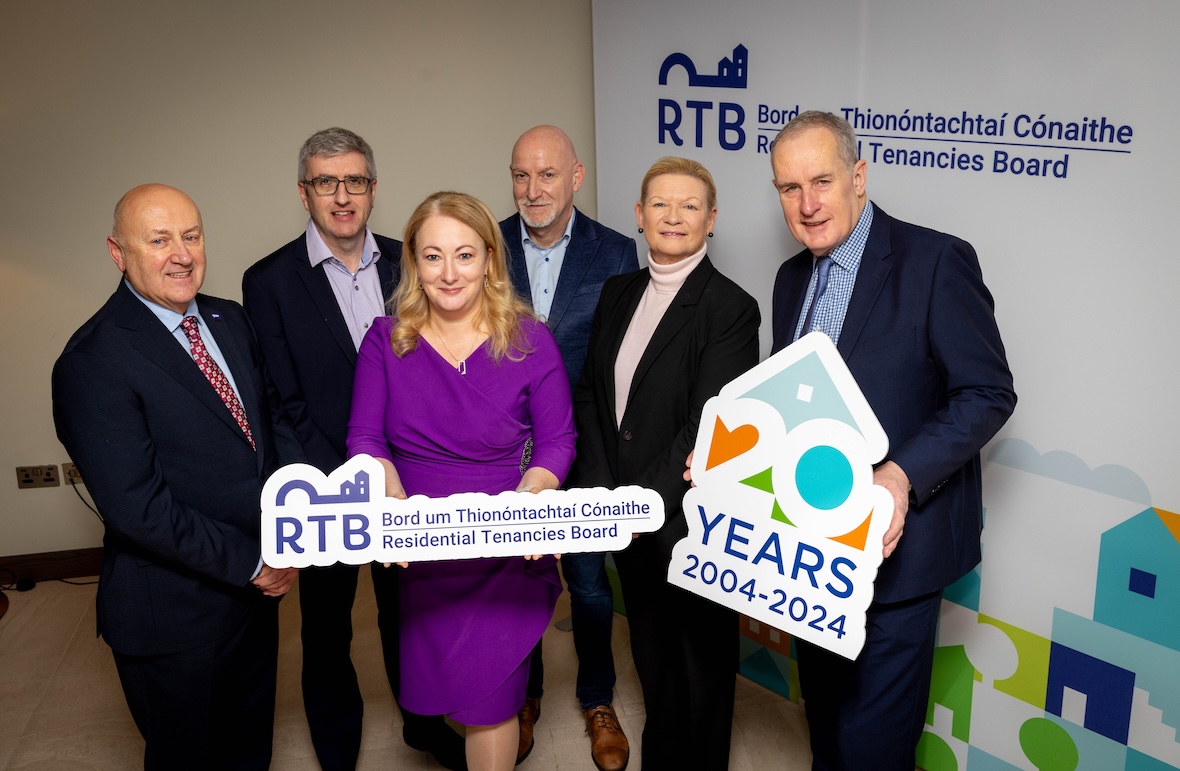 Left to Right: CEO, Institute of Professional Auctioneers and Valuers, Pat Davitt, CEO, Irish Council for Social Housing, Donal McManus, Director of the RTB, Rosemary Steen, CEO, Threshold, John-Mark McCafferty, MC, Eileen Dunne, RTB Chairman, Owen Keegan
Left to Right: CEO, Institute of Professional Auctioneers and Valuers, Pat Davitt, CEO, Irish Council for Social Housing, Donal McManus, Director of the RTB, Rosemary Steen, CEO, Threshold, John-Mark McCafferty, MC, Eileen Dunne, RTB Chairman, Owen Keegan
The Residential Tenancies Board brought leading voices in Ireland’s housing sector together at a conference to reflect on 20 years of the Residential Tenancies Act, and to consider the opportunities and challenges ahead for Ireland’s rental sector. At the event, the RTB released new data on the state of the rental sector to inform this conversation.
The data and studies released today draw on RTB annual tenancy registration data to answer key questions about Ireland’s rental market.
What size is Ireland’s rental sector? Profile of the Register data Q3 2024
The RTB Profile of the Register series is the most authoritative source of data on the size and profile of Ireland’s rental sector. Q3 2024 data shows that:
- Registered private and Approved Housing Body tenancies continue to grow. Registered private tenancies rose by 8.4% annually to 236,198, while Approved Housing Body tenancies have also grown by 15.6% annually to 49,195 in Q3 2024.
- The number of private landlords has increased by 5.7% annually to 104,327. Numbers have now increased in every quarter from Q2 2023 across most sizes of property portfolio from 1 to 100+ tenancies.
What rent are tenants paying today? RTB / ESRI Rent Index Q2 2024
The quarterly RTB / ESRI Rent Index tracks price developments in the Irish rental market over time. It provides the most accurate picture of how average rents are changing for new and existing tenancies in Ireland. Q2 2024 data shows that:
- Growth in average new tenancy rents has slowed. The standardised average rent for new tenancies rose by 4.7% annually to €1,644 in Q2 2024. This is down from a growth rate of 8.3% in Q1 2024. This is primarily driven by Dublin, where annual growth in average new tenancy rents was 2.5% compared with 8.9% outside Dublin.
- Existing tenancy average rents rose faster than new tenancies for the first time, but sitting tenants still pay less. The standardised average rent for existing tenancies rose by 5.8% annually to €1,415. This is €229 lower than for new tenancies.
How are rents changing at individual property level? ESRI Individual Property Level Analysis Q2 2022 – Q1 2024
The ESRI’s Individual Property Level Analysis is a peer-reviewed study that tracked the changes in rent reported for individual properties seen at least twice in RTB registration data from Q2 2022 to Q1 2024 (182,250 matched property pairs). The findings show that:
- Rents at individual property level grew more slowly than average rents in the market-wide Rent Index. The average growth rate in rent across all properties tracked was 2.6%, with 60% of tenants seeing no annual increase in rent.
- Rent increases were lower in RPZs. Rents for individual properties with ongoing tenants in Dublin grew on average by 1.3% annually to Q1 2024, by 1.4% in other RPZs but by 3.5% in non-RPZ areas. Rents for properties where tenants changed in Dublin grew on average by 2.8% annually to Q1 2024, by 5.2% in other RPZs but by 14.0% in non-RPZ areas.
- Large rent increases more likely outside RPZs. 16.5% of ongoing tenants in non-RPZs experienced rent increases of 8% or more compared with 2.8% of tenants in Dublin and 4.8% in other RPZs.
Rosemary Steen, Director of the Residential Tenancies Board said:
“Today is an important day as we mark the RTB’s contribution to Irish society over the last 20 years. The vision to create the RTB as a regulator with powers to resolve disputes outside of the courts was a groundbreaking decision at the time. The new data we have shared demonstrates the significant change in Ireland’s rental sector since 2004, and how our work has grown with it. This data is already informing ongoing public information campaigns and action to drive landlord compliance with RPZ rules and the requirement to register tenancies.”
Brian Gallwey, Senior Research Officer with the RTB data said:
“As the sole custodian of Ireland’s national register of tenancies, we manage an unparalleled source of data on the rental sector. We are passionate about ensuring we deliver critical insights on the changing profile of Ireland’s rental sector to inform policy. In Q3 2024, the number of landlords continued to increase across most sizes of property portfolio from 1 to 100+ tenancies. Landlords with just one property still account for a significant share of tenancies at 25.8% but landlords with 100+ tenancies now account for 12.5% of all tenancies nationally, up from 10.1% one year ago.”
Rachel Slaymaker, Research Officer with the ESRI said:
"While the Rent Index provides the most accurate picture of how the average rent paid by new and existing tenants is changing, changes in average rents are affected by both individual property rent changes and churn in the rental market. The findings from the Individual Property Level Analysis study provide important additional context on what is happening at an individual property level. This study shows us that despite the average rent paid by new and existing tenants across Ireland rising, 60% of properties tracked in this study saw no increase in rent compared to the previous year.”
To access the data released in the Profile of the Register, please visit RTB Data Hub.







